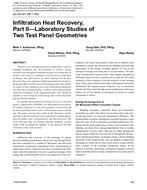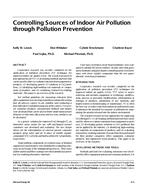In this paper it is shown that the radiation interchange algorithms of the NBSLD and BLAST loads programs can be significantly improved. It is proposed that the radiant interchange in a room can be adequately modeled by assuming that each surface radiated to a fictitious surface which has an area, emissivity, and temperature giving about the same heat transfer from the surface as in the real multi-surface case. This approximation leads to a more accurate heat balance and can be used for large numbers of surfaces without greatly increasing computation time. The algorithm will make it computationally practical to account for previously neglected effects such as nonlinear, nonconstant interior convection coefficients and heat conduction between simultaneously simulated rooms. It would also be possible to do calculations of room loads and temperatures as they are affected by the operation of the air distribution system.
Product Details
- Published:
- 1980
- Number of Pages:
- 19
- File Size:
- 1 file , 1.3 MB
- Product Code(s):
- D-DV-2599
- Note:
- This product is unavailable in Russia, Belarus


